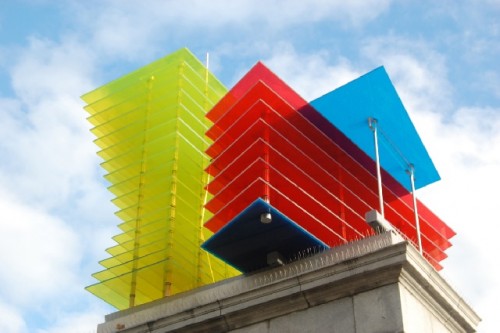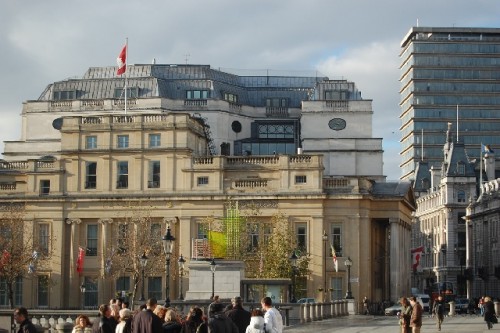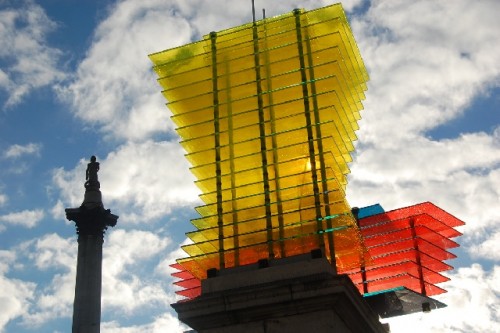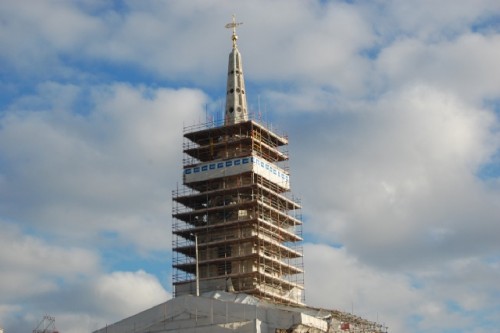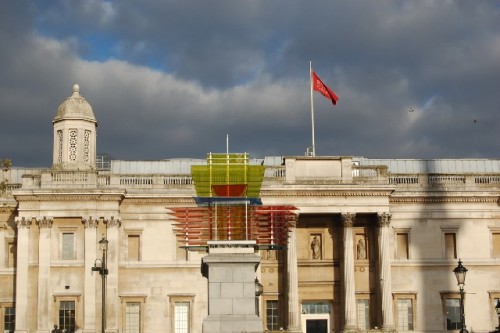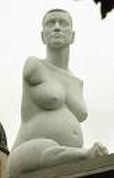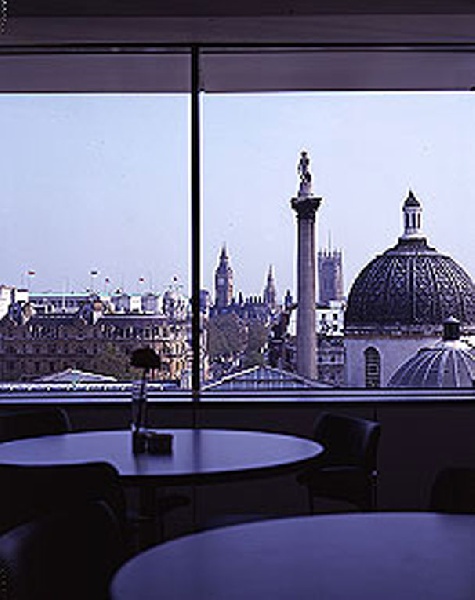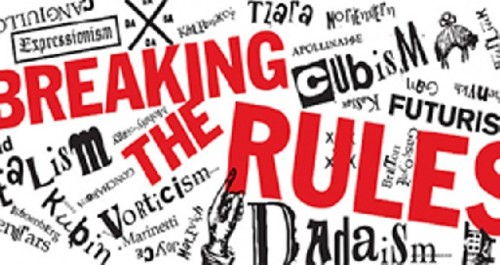Is Temporary Public Art Fair in Trafalgar Square?
The Fourth Plinth, No Lunch at the National Portrait Gallery, No Show at the London ICA and Other Very Odd Happenings in the London Scene.
By: Mark Favermann - Dec 08, 2007
Public Art in the best of circumstances can be controversial, mediocre or just bad or unjustified. London and all of the UK seem to have a much more adventurous spirit in regard to public art than we do in New England. For the past few years, there has been a public art initiative in the heart of perhaps London's most visited ceremonial public space, Trafalgar Square. The public art projects are placed there for a year or two and then changed to another artist's work. The placement is at the Fourth Plinth.
A few of the pieces have been provocative and even rather wonderful like the previous one. This previous piece was created by sculptor Marc Quinn. It was called Alison Lapper Pregnant and conveyed the image of a disabled pregnant woman set like an ancient Greek or Roman heroic statue. The current piece is a bore and seems so been there, done that and even bought the t-shirt that no one with any artistic sophistication (other than the jury) can understand why it is even there.
It is a piece by Thomas Schütte, a highly shown and thus esteemed German artist. He must have been chosen for his previous work, because this piece is well below his best. According to the artist, it is a conceptual model of a proposed hotel. Without any grace or aesthetic sensitivity, the 8.5 "tonnes" piece is unimaginative and rather unnecessary. Schütte is certainly better than this. The piece is made up of stainless steel and colored Plexiglas sheets. It is absolutely simple-minded. Underwhelmingly, it has very little visual resonance against the nearly 200 year old statuary and museum buildings. In fact, the scaffolding on the restoration of St. Martin's in the Field Church a block away has more visual impact. My photographs give it more vibrancy than is caught by the eye. I guess you can't win them all.
The Fourth Plinth is located in the northwest corner of Trafalgar Square, opposite the Sainsbury Wing of the National Gallery. The square was originally designed by Sir Charles Barry in 1838 and built in 1841 to celebrate Admiral Nelson's 1805 naval victory over the French. Nelson's Column was built in the 1840s and dominates London's first open public square. Over the next hundred years, it became a place to commemorate naval and military heroes of the British Empire. The Fourth Plinth was meant to display an equestrian statue. At the time that it was built, there were insufficient funds to create such a statue and so the fourth plinth remained empty.
In 1998 the Royal Society for the encouragement of Arts, Manufactures and Commerce (RSA) commissioned a series of three works to be displayed temporarily on the plinth, Ecce Homo by Mark Wallinger (1999), Regardless of History by Bill Woodrow (2000) and Monument by Rachel Whiteread (2001). The stated mission of these commissions was to raise public awareness, create examples of the types of artwork that could be created for the plinth and to help resolve its long-term future.
The campaign was very successful and led the Government to set up an independent committee which, informed by public opinion, unanimously recommended that the plinth continue to be used for an ongoing series of temporary works of art commissioned from leading national and international artists.
The apparently enlightened Mayor of London, Ken Livingston, endorsed this recommendation. His office took over responsibility for Trafalgar Square maintenance and oversight in 1999. A panel of specialist advisors (the Fourth Plinth Commissioning Group) was appointed to guide and monitor a systematic program of contemporary art commissions.
Recently, a shortlist of artists for the next commission to go on the Fourth Plinth was announced. The artists are: Jeremy Deller, Tracey Emin, Antony Gormley, Anish Kapoor, Yinka Shonibare and Bob & Roberta Smith. These six have been commissioned to produce a maquette of their proposed work. These models will be shown in the Annenberg Court at the National Gallery starting in early January 2008.
Mayor Livingston has stated, "The last two commissions have generated huge interest and attracted widespread debate about the place and value of public art. The Fourth Plinth commissions have become an integral part of the vision for Trafalgar Square, as a vibrant, accessible public space in the heart of London. I am very much looking forward to seeing the artists' proposals in the New Year." London is aggressively mixing new architecture and design with the old. In fact, London's City Hall is an asymmetrical glass structure and all of London taxis are now handicap friendly. There is a visual excitement in the city. Therefore, the Fourth Plinth, with or without mistakes, is a statement of what can be, not necessarily what ought to be.
So, there it is. Even rather weak public art is a cause for cultural celebration in the UK. There is a needed lesson to be learned here.
Notes and Goats:
Before I left Boston, Charles Giuliano suggested that I treat myself to a lunch/snack and drink overlooking Trafalgar Square. He neglected to tell me what museum restaurant or café at which to do this. So, I went to the Sainsbury Wing of the National Gallery and climbed the stairs to their restaurant. After standing there for about 15 minutes, I asked one of the distracted hostesses if there was a window seat available. At the same time, I realized that the windows really didn't look out on much except mostly a brick wall. So I walked over to the older section of the National Gallery and asked at the information desk if there was a restaurant there. I was then directed to the top floor of the National Portrait Gallery.
I trekked over to the National Portrait Gallery. After uncharacteristically asking directions, I walked up two flights of stairs, took two escalators and one elevator. Eventually, I found myself on the museum's top floor at the restaurant. It was about 2 PM and crowded. I politely asked the hostess how long would the wait be. She answered me by handing me two menus. One was outrageously expensive, and the other was even more outrageously expensive. She informed me that what I chose to eat would determine when and where I was to be seated. Needless to say, I was outraged.
I told her that I did not want to choose my meal standing up. She called the manager. He informed me that I would have to wait 45 minutes for a table, and it would not be at a window. I was so enraged that I backed out of the restaurant and retraced my steps out of the museum. On the way out, I filled in a complaint card and left it at an information desk with a uniformed employee. I do not recommend the Portrait Restaurant to anyone. Be warned and beware.
While in London, I was also interested in going to the ICA, London's Institute of Contemporary Art. I went one morning and saw that the museum didn't open until after 12 PM. Very civilized, I thought. The hours were from 12 to 8 PM. The next day, after some meandering early, I got there about one in the afternoon. I learned that there were no exhibits going on. The ICA was only showing films and acting as a performance space. Art was only in some form of performance. Exhibits were not a major concern apparently in mid-winter. There was no indication of this on the outside of the ICA building. Even conceptual or environmental art may be passé there. I am concerned that this may be the direction of Boston's own ICA in the future as well. Contemporary art without art--who would have thunk it?
Whenever I visited London in the past, there have almost always been major exhibitions at the Royal Academy near Piccadilly. This time, the next major exhibition of works from the Hermitage Museum in Moscow was to be presented in January of 2008. Here was another disappointment. Add to this, the Tate Modern was showing an exhibit of Louise Bourgeois-something that had been shown at the Boston ICA, and at the Design Museum, there was an exhibit of an overview of the work of architect Zaha Hadid-a larger exhibit of her work was at the Guggenheim last year. Nothing was really fresh or new. Of course, the National Gallery had a show of Italian Renaissance paintings. This is sort of the same old, same old, like the MFA's Monets or Impressionists wheeled out every few years. Perhaps, art or at least art curators took a holiday in November and December in London?
Only a wonderful exhibit at, of all places, The British Library saved the day or rather the week. "Breaking the Rules: The printed face of the European Avant Garde 1900-1937," is a spectacular show. The exhibit allows for the exploration of Europe's creative revolution of the early 20th century. This was a revolution that ripped up the rulebooks of visual art, design, photography, literature, theatre, music and architecture, and whose effects are still felt, heard and seen even today.
Mainly through the medium of print, "Breaking the Rules" throws new light on Cubism, Expressionism, Futurism, Dadaism, Suprematism, Constructivism, Surrealism and other movements as well as on the artists who changed the face of modern culture. The show connects the dots between the various isms. Some wonderful rarely exhibited star items included were Marinetti's Futurist experiment with words, type and visual text, Zang Tumb Tuum; the Futurist Burliuk Brothers' "Tango with Cows"; Dada pieces by Tristan Tzara; and the notebooks and corrected proofs of James Joyce's "Finnegan's Wake." There were many, many more.
Drawing from resources that are rare and even more rarely seen, this exhibition could easily take days to thoroughly and thoughtfully review and visually and contextually digest. One is in the presence of greatness here in terms of cultural significance. In addition to a major presentation of books, manifestos, flyers, posters and even album covers, there are also remarkable films and rare historic recordings to see and hear. The excellent catelogue could be used as a textbook in university art history courses.
Though initially disappointed in what could be seen in London, The British Library restored my cultural faith. Art is certainly where you find it.

